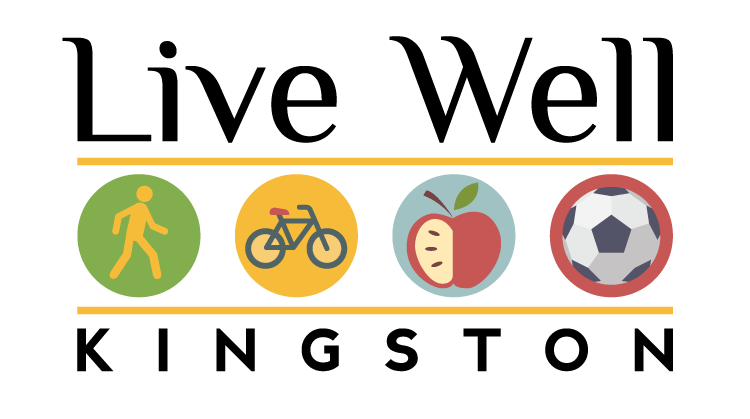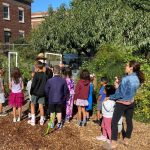Are you gardening or thinking about growing food in Kingston? It’s a great way for increasing access to healthy, nutritious, and low-cost produce. It improves the beauty of a neighborhood, it may increase social interactions, and have many other benefits. It’s a good time to review best practices and some common contaminants that can be found in urban soil.
Are you selecting a new site to garden or already gardening in Kingston?
First, determine the health and suitability of the soil. Consider what the land may have been used for previously. Here is good list of questions to consider. If any of your answers are “yes, I think this may have happened near my soil,” then get a soil test. Read below to find out more about where to get one.
- Lead Paint: Has lead paint been used on the outside of homes or other buildings on or near the property?
- Pesticides: Are pesticide chemicals currently used on the property? Were pesticides used in the past, such as for old orchards or farms?
- Industrial / Commercial Site Use: Is the property near an industrial or commercial site that may be using chemicals or might have used chemicals in the past? Was the property formerly the site of industrial or commercial activity?
- High Traffic Areas: Is the property located near a roadway with frequent traffic?
- Treated Lumber: Were decks, swing sets, playscapes, or other structures on the property built from pressure-treated wood?
- Petroleum Spills: Is there a history of spills or leaks of fuel oil, gasoline or other petroleum products on or near the property?
- Automobile or Machine Repair / Junk Vehicle Storage: Has automobile or other machine repair work been done that may have resulted in chemical spills or dumping on or near the property? Are junk vehicles stored on or near the property?
- Furniture Refinishing: Has furniture been refinished on or near the property?
- Landfill / Garbage Dumps: Is the property near a landfill or garbage dump? Was it formerly the site of a landfill or garbage dump?
- Fires: Have materials been burned on or near the property? Has there been an accidental fire?
- Fertilizers: Are fertilizers used for lawns or gardens on the property? Is the property near farmland or was it formerly used for agriculture?
The possibility of contamination at a garden site should not keep you from planning an urban garden there.
The information here presents steps that you can take to find out and address potential contamination at your site to help create a safe and healthy garden for your community.
Choosing What to Grow
In general, plants that produce fruiting bodies (for example, tomatoes, squash, apple and pear trees, and berries) are most appropriate for growing in potentially contaminated soil. Root and tuber crops (for example, carrots, potatoes and onions) are often the least appropriate plants to grow in potentially contaminated soil, as the edible portions of the crops are in direct contact with the soil. Vegetables with large outer leaves (for example, cabbage, lettuce and collard greens) are easily contaminated by dust and soil splashback, so careful washing of these plants is necessary.
What are Contaminants?
A soil contaminant is an element or chemical present in the soil at a level that could possibly pose health risks. In a few areas of the country, element levels may be naturally high. In many cases, human activities have increased the soil levels of many elements and chemicals and also spread them out more widely. Lead, cadmium, arsenic, zinc, and polycyclic aromatic hydrocarbons (PAHs) are contaminants commonly found in any urban environment. In addition, other contaminants can also be found in areas near former commercial or industrial Properties.
While gardening, the greatest risk of exposure to contaminants is from contaminated soil getting into your mouth or by breathing in contaminated dust. For example, children playing in the garden may directly eat soil through hand-to-mouth play, or people may eat plants without first washing them to remove soil and dust. Skin contact (dermal exposure) with soils containing contaminants such as PAHs, chromium and trichloroethylene (TCE) can pose health risks.
Some edible plants do take up and accumulate contaminants. A plant’s uptake of contaminants depends on many factors, including the type of plant and the pH and organic content of the soil. However, research shows that there is minimal risk of exposure from eating plants grown in contaminated soils. To reduce concerns of exposure from eating plants, wash produce thoroughly before eating to remove potential soil contamination. Root vegetables have a higher potential for accumulating contaminants.
What Can I Do to Lower the Chances of Coming into Contact with Contaminants that May Be in my Soil?
If you find that the soil in which you want to garden is contaminated, you may want to first consult with your state and local environmental agencies and EPA’s Technical Assistance to Brownfields (TAB) program. The following techniques are commonly used to eliminate exposure to soil contaminants:
Build raised beds. Building raised beds and growing plants in containers is the most common way to reduce the chances of coming into contact with contaminants in urban gardens.
Use soil amendments to stabilize contaminants in soil. Adding a thick layer of organic matter to your soil provides a physical barrier to contamination. Soil amendments improve the overall soil quality for growing plants and are a good addition to any soil.
Remove all contaminated soil and replace it with clean soil. Make sure the replacement soil is clean by asking the supplier for proof that the soil that was tested to be contaminant-free.
Use phytotechnologies, which utilize plants to extract, degrade, contain or immobilize contaminants in soil. However, using phytotechnologies to clean up contaminants can take many years, is not effective for every contaminant, and generally requires special handling for the disposal of plants used.
How to Get a Soil Test
Cornell Cooperative Extension of Ulster County does soil tests through the Master Gardener Program. It is $3 for the first sample and $1 for additional samples. Here is more information: http://ulster.cce.cornell.edu/gardening/soil-testing/ Here is the form to fill out: http://ulster.cce.cornell.edu/resources/soil-testing-instructions-and-options-ada-checked
Another place to get soils test is urbansoils.org




